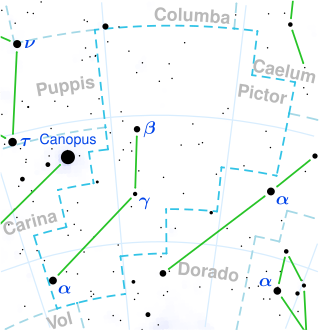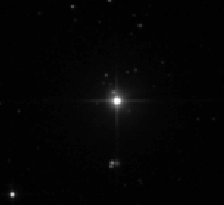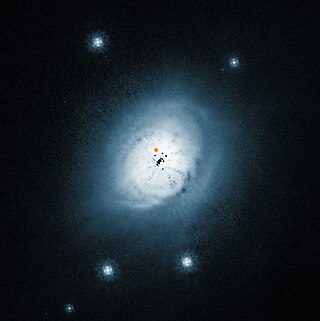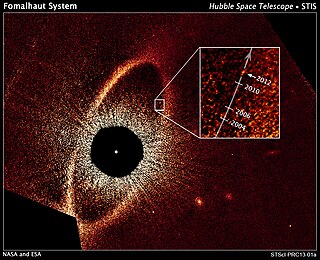
A ring system is a disc or ring, orbiting an astronomical object, that is composed of solid material such as dust and moonlets, and is a common component of satellite systems around giant planets. A ring system around a planet is also known as a planetary ring system.

Fomalhaut is the brightest star in the southern constellation of Piscis Austrinus, the "Southern Fish", and one of the brightest stars in the night sky. It has the Bayer designation Alpha Piscis Austrini, which is Latinized from α Piscis Austrini, and is abbreviated Alpha PsA or α PsA. This is a class A star on the main sequence approximately 25 light-years (7.7 pc) from the Sun as measured by the Hipparcos astrometry satellite. Since 1943, the spectrum of this star has served as one of the stable anchor points by which other stars are classified.

A protoplanetary disk is a rotating circumstellar disc of dense gas and dust surrounding a young newly formed star, a T Tauri star, or Herbig Ae/Be star. The protoplanetary disk may also be considered an accretion disk for the star itself, because gases or other material may be falling from the inner edge of the disk onto the surface of the star. This process should not be confused with the accretion process thought to build up the planets themselves. Externally illuminated photo-evaporating protoplanetary disks are called proplyds.

Beta Pictoris is the second brightest star in the constellation Pictor. It is located 63.4 light-years (19.4 pc) from the Solar System, and is 1.75 times as massive and 8.7 times as luminous as the Sun. The Beta Pictoris system is very young, only 20 to 26 million years old, although it is already in the main sequence stage of its evolution. Beta Pictoris is the title member of the Beta Pictoris moving group, an association of young stars which share the same motion through space and have the same age.

AU Microscopii is a young small star located about 32 light-years away – about 8 times as far as the closest star after the Sun. The apparent visual magnitude of AU Microscopii is 8.73, which is too dim to be seen with the naked eye. It was given this designation because it is in the southern constellation Microscopium and is a variable star. Like β Pictoris, AU Microscopii has a circumstellar disk of dust known as a debris disk and at least two exoplanets.

HD 10647 is a 6th-magnitude yellow-white dwarf star, 57 light-years away in the constellation of Eridanus. The star is visible to the unaided eye under very dark skies. It is slightly hotter and more luminous than the Sun, and at 1.75 billion years old, it is also younger. An extrasolar planet was discovered orbiting this star in 2003.
HD 210277 is a single star in the equatorial constellation of Aquarius. It has an apparent visual magnitude of 6.54, which makes it a challenge to view with the naked eye, but it is easily visible in binoculars. The star is located at a distance of 69.5 light years from the Sun based on parallax, but is drifting closer with a radial velocity of −20.9 km/s.
HD 69830 is a yellow dwarf star located approximately 41 light-years away in the constellation of Puppis. In 2005, the Spitzer Space Telescope discovered a narrow ring of warm debris orbiting the star. The debris ring contains substantially more dust than the Solar System's asteroid belt. In 2006, three extrasolar planets with minimum masses comparable to Neptune were confirmed in orbit around the star, located interior to the debris ring.

HD 12039, also known as DK Ceti, is a variable star in the constellation of Cetus at a distance of 135 ly (41 pc). It is categorized as a BY Draconis variable because of luminosity changes caused by surface magnetic activity coupled with rotation of the star. The stellar classification G4V is similar to the Sun, indicating this is a main sequence star that is generating energy at its core through the thermonuclear fusion of hydrogen. The effective temperature of 5,585 K gives the star a yellow hue. It has about the same mass as the Sun, but only emits 89% of the Sun's luminosity. This is a young star with age estimates ranging from 7.5−8 million years to 30 million years.

Any planet is an extremely faint light source compared to its parent star. For example, a star like the Sun is about a billion times as bright as the reflected light from any of the planets orbiting it. In addition to the intrinsic difficulty of detecting such a faint light source, the light from the parent star causes a glare that washes it out. For those reasons, very few of the exoplanets reported as of April 2014 have been observed directly, with even fewer being resolved from their host star.

A debris disk, or debris disc, is a circumstellar disk of dust and debris in orbit around a star. Sometimes these disks contain prominent rings, as seen in the image of Fomalhaut on the right. Debris disks are found around stars with mature planetary systems, including at least one debris disk in orbit around an evolved neutron star. Debris disks can also be produced and maintained as the remnants of collisions between planetesimals, otherwise known as asteroids and comets.
HD 98800, also catalogued as TV Crateris, is a quadruple star system in the constellation of Crater. Parallax measurements made by the Hipparcos spacecraft put it at a distance of about 150 light-years away, but this value is in high error. The system is located within the TW Hydrae association (TWA), and has received the designation TWA 4.
HD 50554 is a single, Sun-like star with an exoplanetary companion in the northern constellation of Gemini. It has an apparent visual magnitude of +6.84, which makes it a 7th magnitude star; it is not visible to the naked eye, but can be viewed with binoculars or a telescope. The system is located at a distance of 102 light-years from the Sun based on parallax, but is drifting closer with a radial velocity of −4 km/s.

HD 113766 is a binary star system located 424 light years from Earth in the direction of the constellation Centaurus. The star system is approximately 10 million years old and both stars are slightly more massive than the Sun. The two are separated by an angle of 1.3 arcseconds, which, at the distance of this system, corresponds to a projected separation of at least 170 AU.

HD 100546, is a star 316.4 light-years from Earth. It is orbited by an approximately 20 MJ exoplanet at 6.5 AU, although further examination of the disk profile indicate it might be a more massive object such as a brown dwarf or more than one planet. The star is surrounded by a circumstellar disk from a distance of 0.2 to 4 AU, and again from 13 AU out to a few hundred AU, with evidence for a protoplanet forming at a distance of around 47 AU.

HR 8799 is a roughly 30 million-year-old main-sequence star located 133.3 light-years away from Earth in the constellation of Pegasus. It has roughly 1.5 times the Sun's mass and 4.9 times its luminosity. It is part of a system that also contains a debris disk and at least four massive planets. Those planets, along with Fomalhaut b, were the first exoplanets whose orbital motion was confirmed by direct imaging. The star is a Gamma Doradus variable: its luminosity changes because of non-radial pulsations of its surface. The star is also classified as a Lambda Boötis star, which means its surface layers are depleted in iron peak elements. It is the only known star which is simultaneously a Gamma Doradus variable, a Lambda Boötis type, and a Vega-like star.

Fomalhaut b, formally named Dagon, is a directly imaged extrasolar object and former candidate planet observed near the A-type main-sequence star Fomalhaut, approximately 25 light-years away in the constellation of Piscis Austrinus. The object's potential discovery was initially announced in 2008 and confirmed in 2012 via images taken with the Advanced Camera for Surveys (ACS) on the Hubble Space Telescope. Under the working hypothesis that the object was a planet, it was reported in January 2013, that it had a highly elliptical orbit with a period of 1,700 Earth years, assuming the object is planetary. The planetary hypothesis has since fallen out of favor, and most recent analysis places the object on an escape trajectory.
James R. Graham is an Irish astrophysicist who works primarily in the fields of infrared astronomy instrumentation and adaptive optics.

An exoplanet is a planet located outside the Solar System. The first evidence of an exoplanet was noted as early as 1917, but was not recognized as such until 2016; no planet discovery has yet come from that evidence. What turned out to be the first detection of an exoplanet was published among a list of possible candidates in 1988, though not confirmed until 2003. The first confirmed detection came in 1992, with the discovery of terrestrial-mass planets orbiting the pulsar PSR B1257+12. The first confirmation of an exoplanet orbiting a main-sequence star was made in 1995, when a giant planet was found in a four-day orbit around the nearby star 51 Pegasi. Some exoplanets have been imaged directly by telescopes, but the vast majority have been detected through indirect methods, such as the transit method and the radial-velocity method. As of 1 February 2023, there are 5,307 confirmed exoplanets in 3,910 planetary systems, with 853 systems having more than one planet. This is a list of the most notable discoveries.

HD 115600 is a star in the constellation Centaurus and a member of the Scorpius–Centaurus association, the nearest OB association to the Sun and the host star of a bright Kuiper belt-like debris ring.















